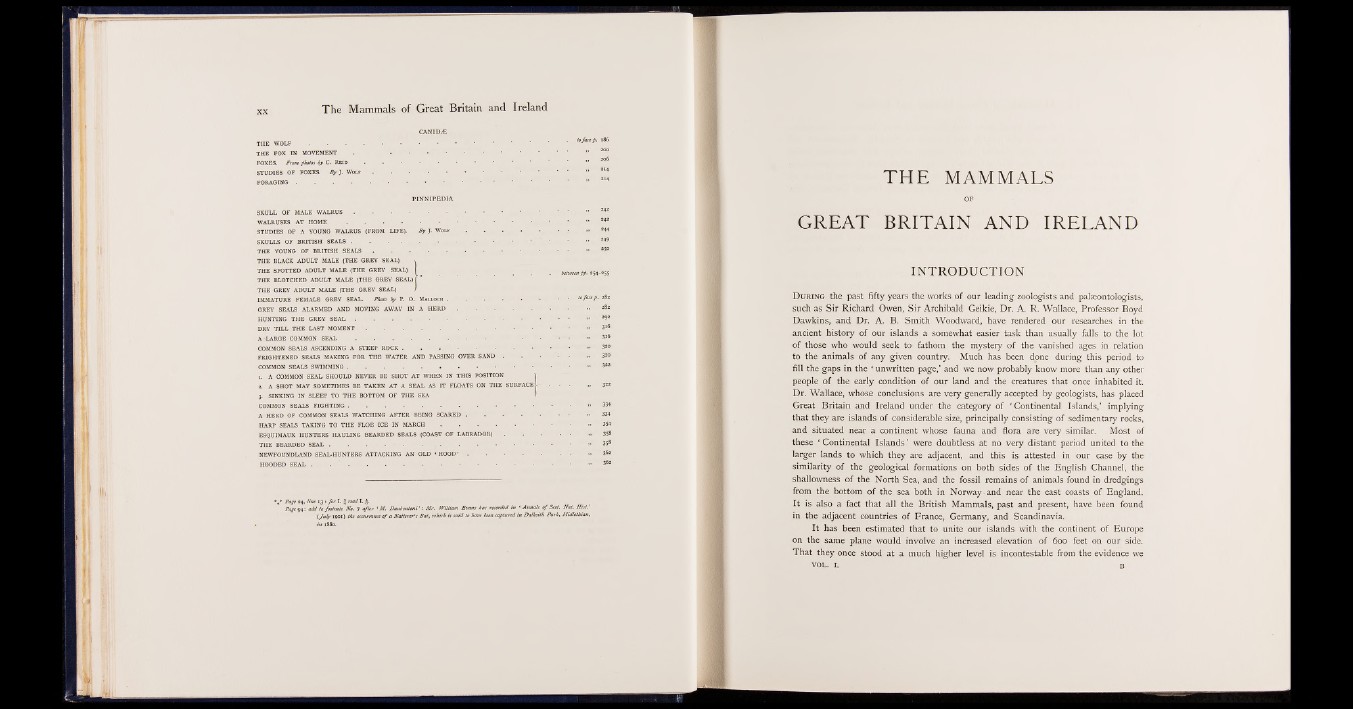
CANIDS
THE WOLF . . • • • • • •
THE FOX IN MOVEMENT . . . . .
FOXES. From photos by C. Rbid •
STUDIES OF FOXES. By J. Wolf . . . . .
FORAGING............................................
PINNIPEDIA
SKULL OF MALE W A L R U S .................................................................. •
WALRUSES AT H O M E ....................................................... ..........
STUDIES OF A YOUNG WALRUS (FROM LIFE). By J. Wolf . . . .
SKULLS OF BRITISH SEALS...........................................................................................................
THE YOUNG OF BRITISH S E A L S ........................................................................................
THE BLACK ADULT MALE (THE GREY SEAL)
THE SPOTTED ADULT MALE (THE GREY SEAL)
THE BLOTCHED ADULT MALE (THE GREY SEAL)
THE GREY ADULT MALE (THE GREY SEAL) J:
IMMATURE FEMALE GREY SEAL. Photo by P. O. Malloch . . . . .
GREY SEALS ALARMED AND MOVING AWAY IN A H E R D ...................................
HUNTING THE GREY S E A L ....................................................................................................
DRY TILL THE LAST MOMENT
A LARGE COMMON SEAL . . . . . . . .
COMMON SEALS ASCENDING A STEEP ROCK ..............................................................................
FRIGHTENED SEALS MAKING FOR THE WATER AND PASSING OVER SAND .
COMMON SEALS SWIMMING...............................................................................................................
1. A COMMON SEAL SHOULD NEVER BE SHOT AT WHEN IN THIS POSITION )
2. A SHOT MAY SOMETIMES BE TAKEN AT A SEAL AS IT FLOATS ON THE SURFACE
3. SINKING IN SLEEP TO THE BOTTOM OF THE SEA
COMMON SEALS FIGHTING............................................................................. ...........
A HERD OF COMMON SEALS WATCHING AFTER BEING SCARED . . . .
HARP SEALS TAKING TO THE FLOE ICE IN M A R C H .......................................................
ESQUIMAUX HUNTERS HAULING BEARDED SEALS (COAST OF LABRADOR)
THE BEARDED SEAL . . . . . .
NEWFOUNDLAND SEAL-HUNTERS ATTACKING AN OLD ‘ HOOD’ . . . .
HOODED SEAL . . ' . . . . ■
to face p. 186
206
>• 2*4
242
249
250
l pp. 254-255
316
316
320
320
334
334
354
358
358
362
362
* Page 24, line 13 for \.\ read I. J.
Page 94: add to footnote No. 7 after ‘M. Daubenloni’ : Mr. William Evans
(July 1901) the occurrence of a NatterePs Bat, which is said to he
■ ecorded in ‘ Annals of Scot. Nat. Hist
it captured in Dalkeith Park, Midlothian
THE MAMMALS
OF
GREAT BRITAIN AND IRELAND
INTRODUCTION
During the past fifty years the works of our leading zoologists and palaeontologists,
such as Sir Richard Owen, Sir Archibald Geikie, Dr. A. R. Wallace, Professor Boyd
Dawkins, and Dr. A. B. Smith Woodward, have rendered our researches in the
ancient history of our islands a somewhat easier task than usually falls to the lot
of those who would seek to fathom the mystery of the vanished ages in relation
to the animals of any given country. Much has been done during this period to
fill the gaps in the * unwritten page,’ and we now probably know more than any other
people of the early condition of our land and the creatures that once inhabited it.
Dr. Wallace, whose conclusions are very generally accepted by geologists, has placed
Great Britain and Ireland under the category of ‘ Continental Islands,’ implying
that they are islands of considerable size, principally consisting of sedimentary rocks,
and situated near a continent whose fauna and flora are very similar. Most of
these * Continental Islands ’ were doubtless at no very distant period united to the
larger lands to which they are adjacent, and this is attested in our case by the
similarity of the geological formations on both sides of the English Channel, the
shallowness of the North Sea, and the fossil remains of animals found in dredgings
from the bottom of the sea both in Norway and near the east coasts of England.
It is also a fact that all the British Mammals, past and present, have been found
in the adjacent countries of France, Germany, and Scandinavia.
It has been estimated that to unite our islands with the continent of Europe
on the same plane would involve an increased elevation of 600 feet on our side.
That they once stood at a much higher level is incontestable from the evidence we
vol. 1. b